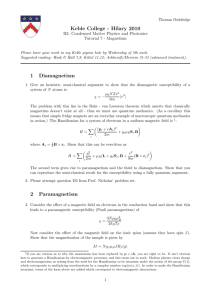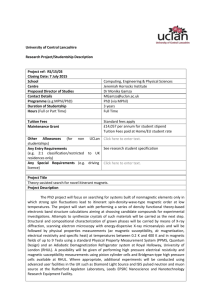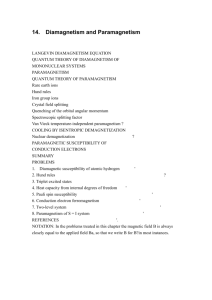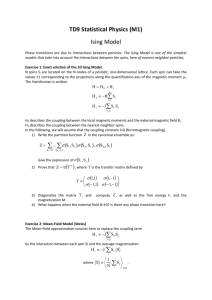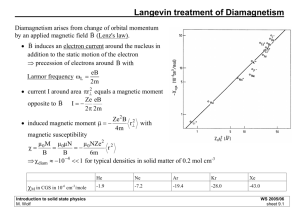and paramagnetism (Larmor, Van Vleck, Hunds rules, etc.)
advertisement
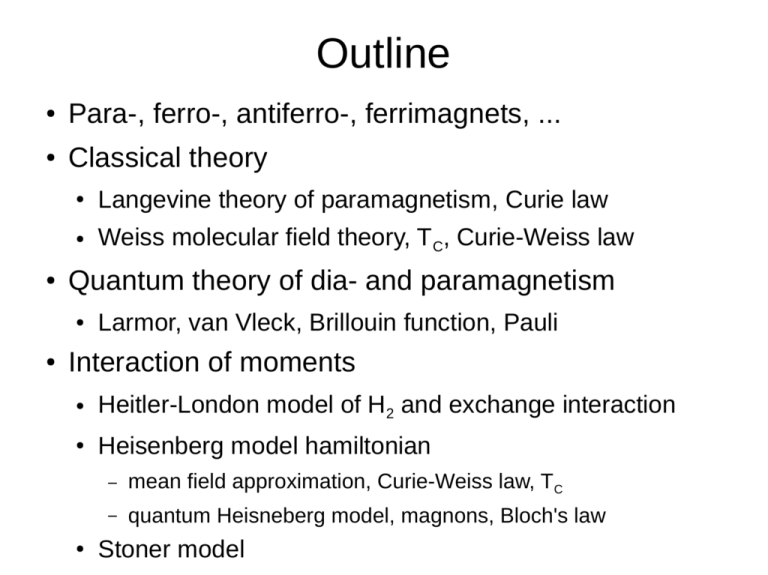
Outline ● Para-, ferro-, antiferro-, ferrimagnets, ... ● Classical theory ● ● Langevine theory of paramagnetism, Curie law ● Weiss molecular field theory, TC, Curie-Weiss law Quantum theory of dia- and paramagnetism ● ● Larmor, van Vleck, Brillouin function, Pauli Interaction of moments ● Heitler-London model of H2 and exchange interaction ● Heisenberg model hamiltonian ● – mean field approximation, Curie-Weiss law, TC – quantum Heisneberg model, magnons, Bloch's law Stoner model Types of magnetic structures Classical theory of paramagnetism ● Model of Langevin – magnetic moment as a vector in magnetic field ● Energy of moment m in field H=(0,0,H): ● Mean value of magnetization on atom where Langevin function is defined as ● Susceptibility (for large T) Curie law (inverse proportionality to T) Weiss molecular field theory ● Attempt to explain magnetic order ● Introduction of an internal field caused by neighboring atomic moments ● Huge fields ~1000T! No physical interpretation by Weiss ● In zero external magnetic field, using Langevin theory we get → graphical solution: ● For T>Tc there is only a solution M=0 ● Critical temperature ● Susceptibility → Curie-Weiss law Towards quantum theory ● Langevin's and especially Weiss theories describe a wide range of magnetic phenomena relatively well ● ● paramagnetism, ferromagnetism, antiferromagnetism (Néel – Nobel prize 1970), ferrimagnetism – both latter cases can be qualitatively described as two nonequivalent sublattices generating the internal magnetic field on each other ● lack of mechanism for the internal magnetic field ● the Langevin's function does not fit too well for many systems ● no explanation of magnetocrystalline anisotropy, metamagnetic transitions, etc. Quantum theory ● ● ● improves over the Langevin's function and provides explanation of the internal magnetic field insight into MAE, crystal field excitations, ... complete ab initio theory of magnetism consistently treating localized and band character of electrons is still lacking Macroscopic definitions ● Thermodynamics: free energy ● Magnetization ● Susceptibility ● Force in inhomogeneous magnetic field Electrons in magnetic field ● change of canonical momentum operator ● the kinetic energy operator becomes ● add interaction of spins with magnetic field ● summary of new terms in Hamiltonian Perturbation theory ● the new terms are small at fields which we can produce in laboratories, therefore we treat it as a perturbation ● susceptibility is 2nd order in H ● changes in energy levels up to 2nd order in H: ● ● the linear term is of the order of ~1 meV in fields ~10 T, the other terms are 3-4 orders of magnitude smaller individual terms lead to a dia- or paramagnetic behavior of the system in magnetic field Larmor diamagnetism ● insulators, closed shells in ground state (L=S=J=0), i.e., only last term contributes ● ground-state energy change due to mag. Field: ● if all excited states are high in energy, then ● This is Larmor diamagnetic susceptibility (negative), typically ~10-5 Hund's rules (1) Maximize the total spin S. A.k.a. “the bus seat rule”. Maximizing spin reduces screening and allows electrons to get closer to cores. (2) While fulfilling (1), maximize the total orbital momentum L. Classically: orbiting in the same direction reduces probability that electrons meet, i.e., reduces repulsion. (3) For less than half-filled shells J = |L-S| and for more than half-filled shells J = L + S. This is a consequence of spin-orbit coupling Van-Vleck paramagnetism ● if J=0, but not L or S, the first term vanishes ● we get two non-zero terms in susceptibility ● first term is Larmor diamagnetism ● second term is Van-Vleck paramagnetism (positive) ● if the first excited state is close in energy to the ground state, more complicated formulas apply Paramagnetism ● For atoms with unfilled shells with nonzero S, L and J, the first term is nonzero and dominates ● We have (2J+1) degenerate state in zero field ● In nonzero field we need to diagonalize (2J+1)x(2J+1) matrix with elements ● Wigner-Eckart theorem states ● with Landé factor Paramagnetism ● Thanks to Wigner-Eckart theorem we see that the matrix is actually diagonal we can interpret (within the lowest J-multiplet) as a magnetic moment of the ion ● ● To get susceptibility we need to consider all these (2J+1) states split by magnetic field Free energy Brillouin function From free energy we get magnetization where Brillouin function is defined by At low temperatures BJ=1 At high temperatures Curie's law ● At high temperatures we get for susceptibility i.e., susceptibility is inverse-proportional to temperature – Curie law ● ● This paramagnetic susceptibility is at room temperature of the order of 10 -210-3 and thus dominates the diamagnetic contribution Comparing to the Curie-law derived in the classical case, we can define an effective moment / effective Bohr magneton number p: Example: rare-earth paramagnets Good agreement theoryexperiment, except for Sm & Eu Sm & Eu have low-lying excited states, which we neglected Example: 3d transition metals For 3d transition metals Curie's law works if we assume L=0 Quenching of orbital momentum due to crystal field splitting Modification of the third Hund's rule Magnetism of conduction electrons ● Delocalized conduction electrons ● Magnetic field shifts energy levels by ● Since we can expand density of states and obtain for number of occupied states i.e., the magnetization is Pauli paramagnetism ● From magnetization we get a susceptibility which is independent of temperature ● This contribution is called Pauli paramagnetism ● It is of order 10-6, i.e., comparable to Larmor diamagnetic contribution ● Note: conduction electrons also have Landau diamagnetic contribution to susc., see A&M Sources (29.4. & 6.5.) ● Main source: Ashcroft & Mermin: Solid State Physics ● ● Chapter 31: Diamagnetism and Paramagnetism (29.4.) ● Chapter 32: Electron Interactions and Magnetic Structure ● Chapter 33: Magnetic Ordering See also: Mohn: Magnetism in the Solid State ● Chapter 7: Heisenberg Hamiltonian ● Section 16.1: Heitler-London Theory for the Exchange Field Interaction between moments ● ● ● ● We developed a quantum theory of magnetic susceptibility originating from various terms (Larmor, van Vleck, nonzero-J paramagnetism, Pauli) So far we included no interaction between moments → no mechanism for a spontaneous magnetization in zero external magnetic field Possible sources of such interaction: ● Dipolar – too weak, ~0.1meV ● Spin-orbital – stronger in heavy elements, up to ~1eV for actinides ● Electro-static + Pauli principle – the strongest, ~1eV and more Heitler-London model of hydrogen molecule as a starting point for constructing model Hamiltonians for interactions of localized moments Hydrogen molecule (summary) ● ● ● ● Two electron system, four possible spin arrangements We can classify them as spin singlet (S=0) and spin triplet (S=1): The ground state is singlet If we neglect all the higher excited states and restrict ourselves to singlet & triplet, we can reproduce the energy levels by the following model Hamiltonian expressed in spin-space only: Heitler-London model of H2 ● 2 hydrogen atoms, 2 electrons, assumption that there is always one electron close to every proton → symmetric and antisymmetric wavefunctions ● the complete Hamiltonian can be written as ● energies of the spatially symm./antisymm. states are where Heitler-London model of H2 ● ● ● Let's add spins → possible spin configurations for two electrons: ● S=0, MS=0 – spin singlet – antisymmetric in spins ● S=1, MS=-1,0,1 – spin triplet – symmetric Total 2-electron wave-function is always antisymmetric → lower lying state that is symmetric in orbital space must have antisymmetric spin part, i.e., spin singlet & higher lying state, which is antisymmetric in orbital space will have be a spin triplet Using relations the same energy levels can be directly obtained by ● we introduced “exchange constant” → generalization gives Heisenberg model hamiltonian Heisenberg model ● ● ● ● Generalization of the situation with hydrogen molecule: Extracting Jij is not a trivial problem and to some extent it is still not completely solved Solving the quantum model itself without approximations is computationally unsolvable except for smallest systems Mechanisms/sources of Jij (Olle's lecture next week): ● Direct exchange ● Super-exchange ● Indirect exchange (RKKY) ● Itinerant exchange Magnetic structures ● J>0 for nearest neighbors → ferromagnet ● J<0 for nearest neighbors → antiferromagnet ● non-negligible J's for more distant neighbors or in geometries leading to magnetic frustrations → more complicated magnetic structures, e.g., spin spirals, non-collinear structures, etc. Mean-field theory – Weiss field ● rewrite the Heisenberg model, including field: ● this looks like a set of spins in effective field which does not depend on i due to periodicity ● yet, the effective (Weiss) field is an operator → the mean-field theory replaces it with its thermodynamic mean value Critical temperature ● Taking mean-field approximation and zero external field we obtain equation ● When M(T) goes to zero, and we get the mean-field approximation of the magnetic transition temperature ● Weak points: over-estimation of TC, wrong low-temperature behavior, also around TC More advanced methods ● ● ● ● Random-phase approximation Monte-Carlo simulations – exact answers within the classical Heisenberg model, though demanding calculations Using numerical methods we can also get M(T) within all three methods Doing Monte-Carlo Heisenberg model quantum-mechanically is still an active field of research Ground state of ferromagnet ● At T=0, all moments aligned parallel, i.e., total moment NS → |NS,NS> ● Rewrite Heisenberg Hamiltonian using raising and lowering operators: ● Applying the HH on the |NS,NS> gives i.e., it is an eigenstate of the HH ● No lower energy-state of ferromagnetic HH exists → it is a ground state |0> Hint: Low-T excitations of ferromagnet ● ● Lowering spin projection by one at one site is not an eigenstate of HH: Because can construct linear combinations , i.e., translational invariance, we which are eigenstates of Heisenberg Hamiltonian: ● One can show that Low temperature magnetization ● ● ● Superposition of magnons (like for phonons) is only an approximation here, but “quite OK” for low-lying excited states The magnetization is reduced by one per magnon, i.e. At low temperatures only the lowest energy excitations happen, and for these i.e., Bloch's 3/2 law ● Mermin-Wagner theorem → no magnetization in 2D or 1D Ground state of antiferromagnet ● Intuitively: arrangement of alternating up/down moments ● It is not an eigenstate of Heisenberg Hamiltonian! ● Assume S=1/2 chain and apply i j i j ● In classical case (spins as vectors) this is a ground state with lowest energy ● For nearest-neighbor (NN) interaction the following bounds are valid: which actually coincide in the classical case, where

